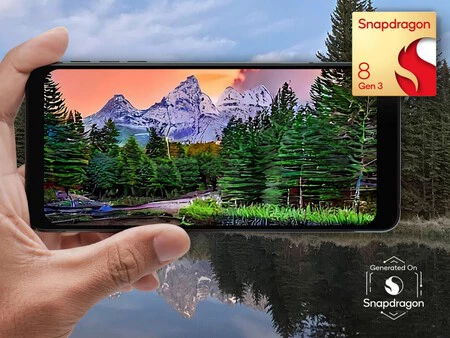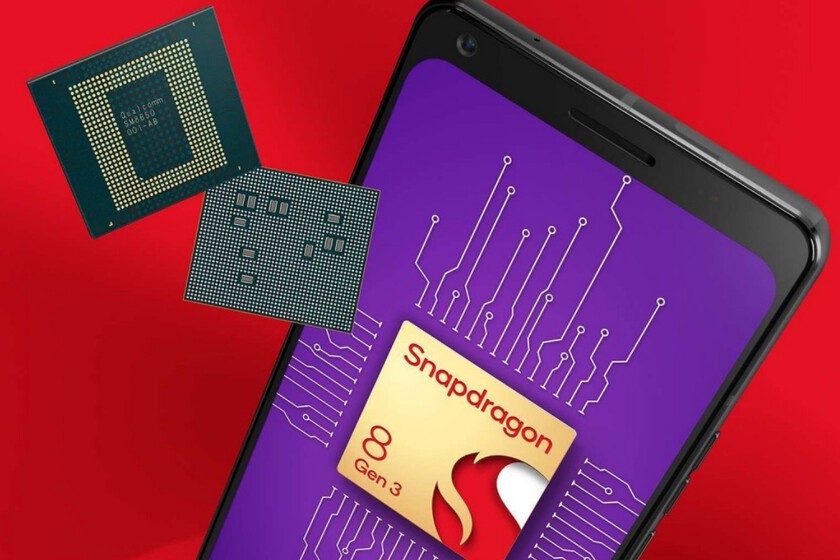The Snapdragon 8 Gen 3 aims high in several fields such as artificial intelligence, although it will depend on Android manufacturers whether or not to take advantage of its capabilities
We already have with us what will surely be the best processor for Android phones of the next 12 months. Its about Snapdragon 8 Gen 3, clearly aimed at the highest range of Android. As expected, apart from raw power and graphical performance, AI also has its share in the cake of novelties.
We are precisely at a time when there is a race to implement artificial intelligence everywhere. The problem is that it is not always useful, nor does it end up working in practice as it does in theory. Therefore, the challenge for manufacturers and developers is to know take advantage of the raw materials provided by Qualcomm with the new Snapdragon 8 Gen 3.
Again, it all depends on the manufacturers
In a presentation and in some first tests that have been measured to the millimeter by Qualcomm, it is common to raise expectations to the maximum. In all areas too, starting with the pure and simple performance of the processors in demanding tasks, in addition to seeing to what extent that performance is sustained.

In fact, it is not unusual to find performance tests whose scores surpass the latest Apple chip. Although the Cupertino company’s processors are not exactly Qualcomm’s competition as they do not market them beyond their own iPhones, there is no doubt that they are the ones that traditionally do a better job when it comes to the brain of a mobile phone.
This year is no exception and in some benchmarks there are better scores for the Snapdragon 8 Gen 3 compared to the Apple A17 Pro. Encouraging to say the least and good proof that, if you want, the sky of an Android mobile can be almost unreachable. The problem is that it is not always wanted.
There are many Android brands suspicious of integrating this Snapdragon 8 Gen 3 in some of their upcoming phones. In fact, we would say that practically all those that market high-end, with the exception of Google, which seems to remain firm in its commitment to Tensors. However, and despite Qualcomm’s good work in its exhibition phones, we have not yet seen what this chip is capable of in a real phone that is going to be put on sale. And using popular expressions, the idea of if I do not see it, I do not believe it.
There are many cases of manufacturers accused of throttling on their phonesand although the reason why they do so may be justified in favor of better temperature and/or battery management, it is still frustrating for a user who on many of those occasions loses the power of decision.
Implementing useful and powerful AI will be the challenge for 2024
The processes generated by artificial intelligence, no matter how simple they may seem, require an enormous amount of resources. Not even the Snapdragon 8 Gen 3, loaded to the gills to be able to run them on the chip itself, will be capable of many. However, Qualcomm has taken a giant step at this point so that most of the requests are resolved this way, from the device itself and efficiently.
We have already seen manufacturers like Google incorporate artificial intelligence functions in the Pixel 8 such as the creation of wallpapers, although in a much more limited way than others. AI image generators that we know. Limited both in the customization of requests and in the time they take to process.
Although the case of the Pixel 8 is somewhat different, since its Tensor G3 was already inferior to the Snapdragon 8 Gen 2 in many fields, it can serve as an example of poorly applied AI technology. And, frankly, it would be a disappointment to see them below Google with everything that the new Qualcomm chip incorporates.
The Snapdragon 8 Gen 3 It has an NPU that is 98% faster than that of the Snapdragon 8 Gen 2. Qualcomm has named it Hexagon and it supports generative AI, which is born from a manufacturer’s agreement with Meta. This gives it full compatibility with LLaMA2 allowing calculations to be performed within the chip itself.
One of the examples of useful applications of this AI taking advantage of Hexagon It is precisely one of those that Qualcomm itself exposes: photography. Many fields open up here, the main one being the improvement of photography once it is taken. See being able to eliminate unwanted objects or even refine certain elements such as noise to improve image quality.
However, we return to the same thing. These are just some of the possibilities offered by the Snapdragon 8 Gen 3. Qualcomm provides the technology and developers and manufacturers must provide the ideas. And not only that, but also being able to apply them correctly and be useful. Because yes, AI also has a lot of marketing and there are quite a few projects that have emerged in recent months that champion artificial intelligence, but in a somewhat dubious way as far as usefulness is concerned.













